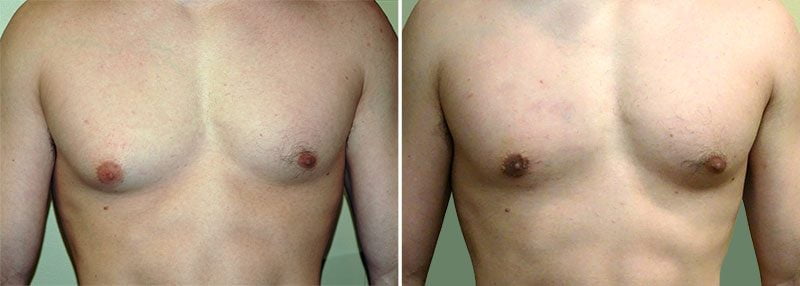Get a more masculine chest contour with male breast reduction
A commonly sought cosmetic procedure for men, male breast reduction corrects a condition called gynecomastia, a benign enlargement of male breasts caused by a number of factors. Some causes of gynecomastia include hormonal changes, heredity, disease, and the use of certain drugs. This condition, which can cause enlargement of one or both breasts, is a source of self-consciousness and embarrassment for many who suffer from it.

View our Gynecomastia before and after gallery »
Though gynecomastia is a much more common condition than most men realize, it can be a great source of shame, causing many to shy away from the physical and intimate activities they enjoy. In some cases, non-surgical treatments prove effective for gynecomastia, but for others in West Virginia, Pennsylvania, and Maryland, plastic surgery can offer the positive change they seek. Dr. Henry Garazo, a plastic surgeon in Frederick, offers this procedure to our patients.
“Dr. Garazo and staff are amazing to work with. They are very professional and personable. They take the time needed to make your experience comfortable. They care about each and every one of their clients. Before, during and after my procedure I always felt at ease. I highly recommend Dr. Garazo.”
—5-Star Google Review
- Key Benefits
- Glossary
- Improved Chest Contour: Male breast reduction surgery removes excess fat and glandular tissue, resulting in a firmer, flatter, and more traditionally masculine chest contour.
- Quick Recovery: Most patients resume normal activities within a few weeks, leading to a swift return to daily life, workouts, and an improved quality of life.
- Minimal Scarring: With advanced surgical techniques, scarring can be minimized, making the signs of surgery less noticeable.
- Lasting Results: While weight gain or hormonal changes can affect the outcome, the results of male breast reduction surgery are generally long-lasting, providing a permanent solution to enlarged breasts.
- Anesthesia: Medication administered to prevent pain during surgery; male breast reduction typically involves either local anesthesia with sedation or general anesthesia.
- Compression Garment: Specialized clothing worn after surgery to minimize swelling, provide support, and help shape the chest during the recovery process.
- Excision Technique: A surgical method used in male breast reduction to remove excess glandular tissue and skin, necessary when gynecomastia is primarily caused by glandular issues rather than excess fatty tissue.
- Glandular Tissue: The firm, fibrous tissue in the male breast primarily responsible for the development of gynecomastia, differing from fatty tissue in density and composition.
- Gynecomastia: A condition characterized by the enlargement of male breast tissue, which can affect one or both breasts, sometimes unevenly.
- Liposuction: A surgical technique that removes excess fat from the body using a suction device, often used in male breast reduction when the enlargement is largely due to fatty tissue.
- Mastectomy: Although more commonly associated with breast cancer surgery in women, in the context of male breast reduction, it refers to the removal of excess breast tissue to correct gynecomastia.
- Pseudogynecomastia: A condition resembling gynecomastia, where male breast enlargement is due to excess fatty tissue rather than glandular tissue, often treated effectively with liposuction alone.
- Recovery Time: The period required for healing after male breast reduction surgery, during which activities may be limited and post-operative instructions are followed to ensure optimal healing.
- Scarring: The marks left on the skin after surgery; scarring from male breast reduction varies depending on the techniques used but is generally minimal and strategically placed to be less noticeable.

View our Gynecomastia before and after gallery »
Your male breast reduction procedure at Plastic Surgery Services
Consultation
Men come to Dr. Garazo because he offers a safe, effective treatment for gynecomastia through male breast reduction. During your consultation, Dr. Garazo will discuss your goals, perform a physical evaluation, and review your gynecomastia treatment options.
Good candidates for male breast reduction
Good candidates for the procedure are men of all ages who are bothered by the size of their breasts. They must be in good health physically, have a stabilized breast size, and possess realistic expectations for their surgical results. For adolescents suffering from gynecomastia whose breasts may still be growing, surgical treatment is an option, although a second procedure may be needed at a later date.
The procedure
Dr. Garazo performs all male breast reduction surgeries in his on-site, state-of-the-art Quad-A accredited facility. The surgery begins with the administration of anesthesia by our qualified anesthesia providers, who will ensure your safety and comfort throughout your procedure.
Dr. Garazo will then make incisions, typically around the areola or under the armpits, to minimize visible scarring. Excess glandular tissue, fat, and skin are then removed to create a flatter, firmer chest contour. In cases where a significant amount of fat needs to be removed, Dr. Garazo may use liposuction to effectively target a larger area. The remaining skin is then tightened and the incisions are closed. The entire process usually lasts about 1 to 3 hours, depending on the extent of the surgery.
Recovery
When recovering from male breast reduction surgery, patients will typically wear a compression garment to reduce swelling and support their new chest contour. Pain, swelling, and bruising are common but diminish over the weeks following surgery.
Most patients are able to return to work within a week, although strenuous activities and exercise should be avoided for about three to four weeks.
After male breast reduction surgery, it is essential you allow your body ample time to heal properly before resuming any exercise and/or strenuous activities. You can typically expect the following timeline for returning to physical activities:
- Light Activities: Within the first week, patients are usually able to engage in light activities such as walking. This is encouraged to promote blood circulation and aid recovery.
- Moderate Exercise: After about 2-3 weeks, depending on the patient’s recovery and the surgeon’s advice, moderate exercises such as light jogging or low-intensity cardio can be resumed. During this time, it’s important to avoid activities that could strain the chest muscles or impact the surgery site.
- Extensive Exercise: Please wait at least 4 to 6 weeks, if not longer, to resume any intensive activities or exercise regimens.

View our Gynecomastia before and after gallery »
Results
The final results of the surgery are usually visible within several months, once all swelling has subsided. You can expect to enjoy a more masculine chest appearance, improved body proportions, and often a significant boost in self-confidence. The results from male breast reduction surgery are typically quite long-lasting, especially if you maintain a healthy lifestyle and exercise regimen.
Dr. Garazo can remove excess skin, fat, and glandular tissue from male breasts to create the flatter, more masculine chest many men seek.
Gynecomastia & Male Breast Reduction FAQs
Does male breast reduction surgery use anesthesia?
Yes, male breast reduction surgeries involve the use of anesthesia to ensure the patient is comfortable during the procedure. Depending on the complexity of the procedure and the patient’s health, either general anesthesia (where the patient is completely asleep) or local anesthesia combined with sedation (where the area is numbed and the patient is relaxed but awake) may be used. Depending on your specific needs and preferences, Dr. Garazo will determine which type of anesthesia is best for you during your consultation.
When can I return to work after male breast reduction surgery?
Most patients can return to non-strenuous work within 5-7 days, but this varies depending on the nature of your job and your individual recovery. Dr. Garazo will discuss your job requirements and advise you on how long to take off work.
When can I workout again after male breast reduction surgery?
You can do very light cardio as soon as 2-3 weeks after your procedure. Heavy lifting, intense workouts, and contact sports should generally be avoided for at least 4-6 weeks. The chest needs time to heal fully and the internal tissues need to stabilize before being subjected to significant stress.
How much tissue will be removed during male breast reduction surgery?
The amount of tissue removed depends on how much excess tissue you have and the amount Dr. Garazo can safely remove while keeping your chest area looking natural and firm.
Will there be visible scars after male breast reduction surgery?
Male breast reduction scars are minimal and are typically placed in inconspicuous areas, such as around the areola or in the natural creases of the chest.

View our Gynecomastia before and after gallery »
How do I choose the right surgeon for male breast reduction?
Choose a board-certified plastic surgeon with experience in male breast reduction. Surgeons like Dr. Garazo are trained in preserving and highlighting masculine contours so you feel confident with or without a shirt.
What kind of post-operative care is required after male breast reduction?
We provide easy-to-follow aftercare instructions, which typically include wearing a compression garment, caring for your incisions, avoiding strenuous activities, and attending follow-up appointments to monitor your progress and lift activity restrictions.
Will male breast reduction surgery affect nipple sensation?
Temporary changes in nipple sensation are common, but permanent changes can occur. We will discuss what you can expect during your consultation.
Can male breast reduction be combined with other procedures?
Yes, male breast reduction can be combined with procedures like liposuction in other areas or body contouring to sculpt masculine contours.
How long do the results of male breast reduction last?
For most patients, results are typically long-lasting, but factors like significant weight gain, hormonal changes, or certain medications can affect the outcome over time.

View our Gynecomastia before and after gallery »
Can gynecomastia return after male breast reduction surgery?
While the removed tissue does not typically grow back, gynecomastia can recur if the underlying cause is not addressed, such as hormonal imbalances or weight gain.
What is the difference between gynecomastia and pseudogynecomastia?
Gynecomastia is the enlargement of male breast tissue due to hormonal imbalance, while pseudogynecomastia is due to excess fat without glandular tissue enlargement.
Can male breast reduction be performed non-surgically?
Non-surgical options like diet, exercise, and medication may help reduce chest fat but are usually ineffective for true gynecomastia, which often requires surgical intervention.
Schedule a consultation to learn more
Men can find relief from the embarrassment of gynecomastia. For men considering a male breast reduction, Dr. Henry Garazo invites you to explore your options through a patient consultation. To schedule a consultation at Plastic Surgery Services, contact us online or call (301) 791-1800.
Meet Dr. Henry Garazo

Dr. Garazo is a board-certified plastic surgeon with over 20 years of experience offering aesthetic procedures in the greater Hagerstown, MD area. Known for his thorough, expert, and friendly care, Dr. Garazo is a 6x winner of “Best Plastic Surgeon” in the Herald-Mail Tri-State’s Best Community’s Choice Awards. He prides himself on offering comprehensive, informative consultations and ensures every patient always meets personally with him.
References »
Johnson RE, Kermott CA, Murad MH. Gynecomastia – evaluation and current treatment options. Therapeutics and Clinical Risk Management. 2011;7:145-8. doi: 10.2147/TCRM.S10181.
Swerdloff RS, Ng JCM. Gynecomastia: Etiology, Diagnosis, and Treatment. [Updated 2023 Jan 6]. In: Feingold KR, Anawalt B, Blackman MR, et al., editors. Endotext [Internet]. South Dartmouth (MA): MDText.com, Inc.; 2000-. Available from: https://www.ncbi.nlm.nih.gov/books/NBK279105/
Taheri AR, Farahvash MR, Fathi HR, Ghanbarzadeh K, Faridniya B. The Satisfaction Rate among Patients and Surgeons after Periareolar Surgical Approach to Gynecomastia along with Liposuction. World Journal of Plastic Surgery. 2016 Sep;5(3):287-292.
Cuhaci N, Polat SB, Evranos B, Ersoy R, Cakir B. Gynecomastia: Clinical evaluation and management. Indian J Endocrinol Metab. 2014 Mar;18(2):150-8. doi: 10.4103/2230-8210.129104. PMID: 24741509; PMCID: PMC3987263.
Soliman AT, De Sanctis V, Yassin M. Management of Adolescent Gynecomastia: An Update. Acta Biomedica. 2017 Aug 23;88(2):204-213. doi: 10.23750/abm.v88i2.6665.
Holzmer SW, Lewis PG, Landau MJ, Hill ME. Surgical Management of Gynecomastia: A Comprehensive Review of the Literature. Plast Reconstr Surg Glob Open. 2020 Oct 29;8(10):e3161. doi: 10.1097/GOX.0000000000003161. PMID: 33173677; PMCID: PMC7647635.
Sansone A, Romanelli F, Sansone M, Lenzi A, Di Luigi L. Gynecomastia and hormones. Endocrine. 2017 Jan;55(1):37-44. doi: 10.1007/s12020-016-0975-9.


